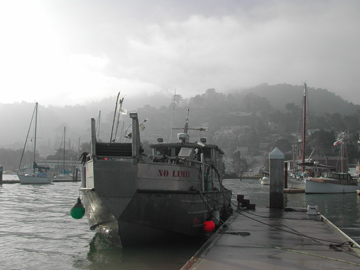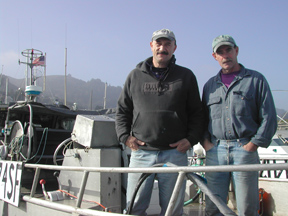Limits for No Limit
 Liquid
gold of San Francisco Bay has turned to silver, but the
fleets come back for more. December to March, the stiff
limits for the fleet keep carefully managed herring schools
healthy in San Francisco Bay. There are 388 permits given
out on a limited schedule for weekday fishing only, in
designated areas. However, not all 388 permits are actively
fished. Fleets add self- regulated buoys to stay clear of
the ferry routes, particularly in Sausalito. Only ten
permits are given out for eggs on kelp or eggs on nets and
ten for fresh herring catches. The fresh herring catch
occurs prior to the commercial roe herring season each year.
Liquid
gold of San Francisco Bay has turned to silver, but the
fleets come back for more. December to March, the stiff
limits for the fleet keep carefully managed herring schools
healthy in San Francisco Bay. There are 388 permits given
out on a limited schedule for weekday fishing only, in
designated areas. However, not all 388 permits are actively
fished. Fleets add self- regulated buoys to stay clear of
the ferry routes, particularly in Sausalito. Only ten
permits are given out for eggs on kelp or eggs on nets and
ten for fresh herring catches. The fresh herring catch
occurs prior to the commercial roe herring season each year.
Herring visit the Bay to spawn between
November and March and sometimes into April. The exact quota
for the amount of fish, live fish, and herring eggs on kelp
that can be taken out of the Bay are based on
recommendations from the Department of Fish and Game. The
Department estimates the amount fish entering the bay and
uses that estimate to set quotas for the following season.
This timely way of defining the limits each year ensures the
limits are matched to the numbers and size of the arriving
fish. Herring is considered the best managed fishery in
California. There are also strict regulations on use and
management of the nets with an associated point system with
hefty fines for any infraction, starting at $200 a point.
Fish and Game provides a hotline with reports of their
surveys to help fishermen fill their quotas. This helps the
fishermen get out of the Bay quickly and leave the fish
alone to spawn in peace sooner. This action ensures
long-term survival of herring in our Bay.
 The
minimum net mesh size for the 2004-05 San Francisco Bay
fishing season is 2-1/8 inches; the mesh size regulations
did not change this year but they can. Each year, most of
the herring fishermen purchase new nets. If a strained net,
or one with a small tear, were to release a catch, it may
end fishing for the day or longer until a replacement net is
put on. In the not too distant past when Japanese buyers for
herring were paying top dollar, one day’s catch could mean
$10,000 lost if the fleet got lucky that day. Boat and
engine repairmen dropped everything when a herring boat
broke down. The price of the fish is way down in today’s
market but it still can mean a notable percentage of the
catch and annual income, causing quite a scramble if a boat
is not ready when the season starts or breaks during the
short periods of time when they can fish. Fishermen have to
follow the 3 P’s rule: Prepare, Prepare, Prepare.
The
minimum net mesh size for the 2004-05 San Francisco Bay
fishing season is 2-1/8 inches; the mesh size regulations
did not change this year but they can. Each year, most of
the herring fishermen purchase new nets. If a strained net,
or one with a small tear, were to release a catch, it may
end fishing for the day or longer until a replacement net is
put on. In the not too distant past when Japanese buyers for
herring were paying top dollar, one day’s catch could mean
$10,000 lost if the fleet got lucky that day. Boat and
engine repairmen dropped everything when a herring boat
broke down. The price of the fish is way down in today’s
market but it still can mean a notable percentage of the
catch and annual income, causing quite a scramble if a boat
is not ready when the season starts or breaks during the
short periods of time when they can fish. Fishermen have to
follow the 3 P’s rule: Prepare, Prepare, Prepare.
Commercial boats are divided into three
fleets. The fleet with the most seniority fish in December.
They are followed by the Odd and Even fleets. They
alternated through the weeks of their season till quotas are
met or March 11th at noon. Individual boats do their best to
catch as much of the fleet limit as they can. It is a
friendly competition of hard working folk. “It was a dismal
year for herring. The overall quota for SF Bay was 3,440
tons (there are 2000 lbs in a ton). The DH or December
platoon did not land any fish. The Odd platoon only caught
76 tons, and the Even platoon caught approximately 67 tons.
Their season ends on March 11 at 1200.” said Becky Ota of
the Department of Fish and Game.” Said Becky Ota, Senior
biologist supervisor and Statewide herring manager
Demand and prices for herring and herring roe may have
fallen off, but it is still there. Along with the Japanese
economy, herring prices are making a very slow recovery.
When two fishermen were asked if it was worth it, the
captain said, “Well…” The crew said, “Sure!”, and laughed.
Both said they wouldn’t do anything else. After herring
season is over, they go fishing for other kinds of fish.
These commercial fishermen work year round in one of the
most dangerous professions, yet there is something that gets
in their blood and they would never change it. They laughed
at the many challenges that they face. It was clear that
they really love to fish and are more than willing to accept
the Department of Fish and Game limits to ensure that they
can continue to have the option to fish for herring in San
Francisco Bay.